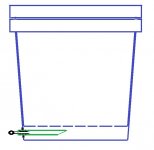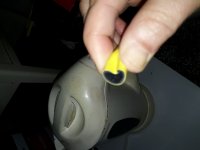StickyBandit
Well-known member
Running the EC1.5 now. Took it to 2.0 and burnt the tips. They use water so fast which boosts EC





Looks to me like the bottom 1/4 of the bucket is where the level never gets below but the pick-up is low down so the draw to the overflow is from the very bottom so there is no stagnant water in the dead spotsWhat am I looking at here? Does the water come up until it overflows. Forming a siphon that lowers the water back down again?
I'm always a bit hesitant with my drains. I have lost a number of plants over the years. Generally where roots grow down the pipes and fill them. First you know is the yellowing, telling you it's too late.
I'm build a bucket system today. My sealing approach might be adaptable.
View attachment 18854273
Typical pot in a pot for me. Bottom one is drilled to take a black rubber grommet. I then put some green hosepipe over a T-piece. Then with a little wetting agent, slid the hose into the grommet. The hose extends to the center, as roots tend to circle at first. The hose is slash cut, to stop roots dropping straight in. Generally a bit of hose has a curve to it, so I will use the curve to have the slash cut end, pushing up on the inner bucket. Each measure is to delay the roots from making their entrance. While the hose over the T takes on the T's barbed shape. So it's snug in the grommet. F&D doesn't make enough pressure to leak, even moving them about, or booting them by mistake. If it's just for drain, a warmed hosepipe will just cram into a tight hole in most cases.
View attachment 18854284
Stuff in through past the pinch, and the pinch will open up to being round again. I did 29 such drains, and not one weeped at all.
I think I'm looking at hard pipe through a hard bucket in your pics, which isn't a working solution.
Plants look nice
It's hard to see how it could leak. Does the pots external spigot (that you put the white coupler on) need lengthening, to reach into the return collection pipe further?
It's handy the spigot takes a 1/2" coupler, as presumably it will take a 1/2" hose to. The dollar shop garden hose is actually a bit smaller than 1/2" at about 12mm ID. It works with 1/2" fittings, they are just selling you the thinnest hose they can get away with. Perfect for a tight fit over a spigot that's more like 13mm. I have a few sizes of garden hose, that should really be the same size, but are not. The cheaper it gets, the less cords, and more it can stretch when warm.
It's an interesting system. Difficult to pulse though, as you can't be sure if one pot is about to syphon, while another already has. They won't be in unison. It's growing on me though.
the problem with hydroton is it needs to be flushed between grows.If you go perlite get paint strainer bags from Sherwin Williams to fit your bucket and keep from clogging your drain.
I would go straight perlite as I have read of many having pH issues with the hydrotron, but maybe it was user related.
If you have any sort of beneficial bacteria in your feed they require a minimum DO. If you dont meet this, that dies off and can be not so great. You running sterile or no?the last system i was running said there was no need to oxygenate the reservoir because the roots aren't in there and it can make pH fluctuate.
If using rockwool, we would cover the blocks. We cut a square of panda sheet, to be just a little bigger than the block. Then cut an X in it, to pass the plant through. Not at 1" size, but passing the 1" through the X when going into 3". It was 3" we prepared the plants in, before the main system. We reclaimed all these squares for reuse.the problem with hydroton is it needs to be flushed between grows.
within 4 weeks of being exposed to nutrient solution hydroton absorbes 12 to 15% Calcium cations and a proportional amount of Potassium cations. It takes about 4 weeks of pure water to wash out the Ca++ and much much longer to flush the potassium.
So flushing between grows requires Anions (negative charged ions) to neutralize it's high Ca++ (positive ions) and reset the medium for the next use. Hydroton's CEC is 20 and attracts positive ions. The sprinkler/ring system you have set up is actually perfect for using hydroton but a lid or some gardeners fabric to cover to prevent moisture loss but many growers go without and it works fine. The sprinkler type system that the ring represents is ideal and helps reduce salt buildup caused by using one or two drip emitters. Keeping the stones humid all the time is essential. so more points go towards that ring/sprinkler set up and the hydroton.
To flush the hydroton between use 90% water, preferably RO and 10% Bleach (negatively charged). The bleach , being negatively charged ions will "pull" and attract the positively charged ions (Ca++ and K) from the hydroton.
I used to do a 72 hour soak in 18 gallon totes rinse and soak again for 24... rinse and it's ready to go again.
Not resetting the Hydroton to neutral is a mistake many growers make when using it and they get a great run in the first time and then everything goes to shit the second run as the Ca++ begins to toxify and lock out potassium and other essential nutrient/macro nutrients.
I grew exclusively in hydroton for a couple years running multiple strains in cash crop rooms. We did very well but there was a bit of a learning curve. Algae wasn't much of a concern unless we rooted in rockwool. For some reason any exposed rockwool above the drip line tended to green up with algae.
good luck, looks like a cool little set up for sure.
many growers make the mistake of thinking they have a PH problem using hydroton when it is actually the hydroton being overloaded with Ca++ and Potassium. It's not a PH problem it is a cation exchange capacity problem.
never used pumice so I can't really say without going to google LOLYou guys are making it too complicatedalthough I do aerate. Learnt a bit about bacteria and equilibriums and toxic die offs while breeding tropical fish
@Tynehead Tom is pumice in a similar boat?